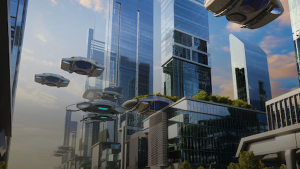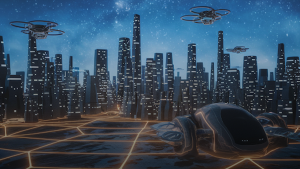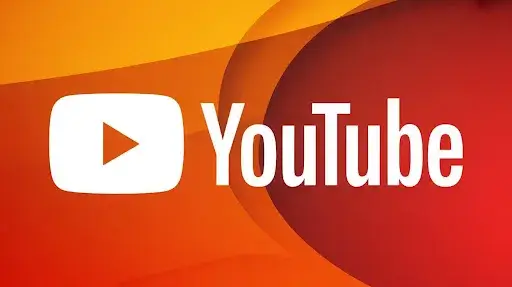3D animation studios and professionals across the world are adopting AI in animation. AI animation is helping them make visuals faster and at a much lower cost.
In a recent report, Market.us mentioned that AI in animation is expected to grow from $1.2 billion in 2023 to $17.7 billion by 2033.
With a rise this big, it’s safe to say we are heading towards a world where animation is not just created but learned and perfected by machines. As the industry evolves, discussions about where animation is headed have become more relevant than ever.
However, it is important to note that AI cannot replace animators. Skilled animators can create unique visuals, while AI can only replicate existing content in different forms. As highlighted in our forward-looking piece on animation trends, animation AI tools must be used as an assistant and cannot replicate the human touch.
This blog gives an overview of the impact of artificial intelligence on 3D animation. How it is adding to realism, speeding up production, and helping AI animators create groundbreaking animations, without additional cost.
Let’s start.
Automation of Repetitive Tasks
Traditional animation required animators to create each frame manually, which was labor-intensive. This got improved with the introduction of digital methods, but still required a lot of effort with keyframing each action.
The ability to automate repetitive and monotonous tasks is one of the key benefits that artificial intelligence offers to the field of animation. Along with animation subtleties, the striving AI has also played a vital part in advancements in realism. AI animation technology can automatically produce in-between frames, undertake AI rotoscoping, and even generate backgrounds and crowd scenes.
3D animation AI tools free up animators’ time so animators can focus on more creative aspects of the present animation and AI animation story.
Animation giant Pixar has reportedly integrated NVIDIA’s AI tools for animation to accelerate their rendering process, allowing for real-time feedback and more efficient iterations.
Aided Creativity
AI tools for animation are not just about efficiency; they also improve creativity. With AI, animators can generate ideas to capture unique styles, discover new storytelling techniques, and create more realistic-to-life characters.
AI-powered animation tools can help AI animators analyze scripts and suggest visual elements that align with them, making the whole 3D animation AI process faster and creating a story that is more relevant to the audience.
Image to 3D animation helps animators create mockups faster that they can use in their projects. Machine learning algorithms can simulate real-world physics, and lighting makes animations more realistic, especially when tailored for dynamic content strategies, like those reshaping social platforms.
Disney is already applying AI for 3D facial modeling to accelerate productivity for loading facial animations and enhance detail and realism in character animations. These animated faces, which can move and change expressions in real time, require more sophisticated imaging sensors. The use of lifelike figures’ depiction enhances audience treatment, which animates characters’ appeals far more than people.
Better Animation Quality
The use of artificial intelligence is a powerful factor in animation technologies. This is achieved by examining a vast range of information, where AI in animation optimizes 3D character rendering processes to make them more polished and lifelike. Even leading game development engines, like Unreal Engine, have started incorporating AI technologies into animation for the creation of next-generation titles with high-quality animations. This gives us a glimpse of how animation will likely change advertising shortly.
A 2D animation creator AI can replicate subtle human movements, mimic a real human, and have more expressive and realistic emotions.
More Personalized Content
Understanding customers’ needs while incorporating their interests to tailor content that is custom requires extensive research. AI tools used in animation help by analyzing user data to identify behavior and preference patterns.
Allowing marketers to create content that resonates with them at a deeper level, which requires a lot of time when done with AI assistance. Ultimately, helping business owners and marketers create marketing strategies that drive more attention and create more sales.
Lower Production Costs
Automating various stages of the 3D animation process with AI helps reduce production costs. This cost-efficiency gives leverage to smaller production houses to compete with larger ones. They can do more iterations and create more experimental projects, which might not have been possible as production can be expensive.
Animation AI allows animators to streamline workflows and optimize resource allocation, giving them a major advantage.
How AI is Helping in 3D Production
Scriptwriting and Pre-Production:
Scripting is an important part of pre-production. Artificial Intelligence helps in analyzing scripts and generating ideas, outlines, and even full-length scripts.
Natural Language Processing (NLP), combined with Machine Learning (ML), is already being utilized by Botnik and Taskade to automate content production.
In the pre-production stage, AI can help with program organizing by managing the schedule, financing, and location scouting. Leveraging analytics and big data enables accurate audience preference predictions, precision casting, and streamlined logistics.
AI storyboarding tools enable transforming written scripts into visual narratives, automating repetitive tasks, and freeing up time to be redirected to creativity and ingenuity.
Production and Visual Effects:
Automated AI tools can manipulate cameras, adjust lighting, track limbs, and create photorealistic 3D animations and visual effects (VFX) duplication.
Neural Radiance Fields (NeRF), employed in 3D animation AI tools, enable the rendering of virtual backgrounds and sets from 2D images, resulting in detailed 2D and 3D AI model animations.
AI-powered animation tools like NVIDIA’s DeepSearch help artificial intelligence VFX artists develop ideal digital sets and lighting that streamline the production process.
Post-Production and Distribution
In post-production, AI 3D animations get assistance with color grading, sound design, and video editing to create an optimized final product.
AI can also predict audience preferences and the commercial success of films, AIding in distribution and marketing decisions.
Limitations of AI in 3D Animation
Despite its many benefits, AI in 3D animation has its limitations. AI tools require significant computational power and can be expensive to implement. Additionally, AI-generated animations might lack the unique creative touch that human animators bring to their work. Ethical concerns, such as job displacement and creative ownership, also need to be addressed to ensure the sustainable integration of AI in the industry.
Best Animation AI Tools
Several AI tools are making waves in the 3D animation industry:
- Runway ML: Provides a suite of AI tools for video editing and animation.
- DeepArt: Generates unique artistic styles for animations.
- NVIDIA AI: Enhances rendering processes and real-time feedback.
- Adobe Sensei: Uses AI for tasks like lip-syncing and motion graphics.
- Midas Creature: Automates complex 2D and 3D animations
The Future is AI
Start working on 3D animation videos, as the future of Artificial Intelligence holds great promise. Prolific Studio is one of the best animation studios in LA that uses AI- and animation-powered technology to redefine the boundaries in the animation industry.
By using AI for animation, professional animation studios like ours are aiding their creativity and producing more robust and powerful content at scale.
Contact us today to get started on your next animation success.









